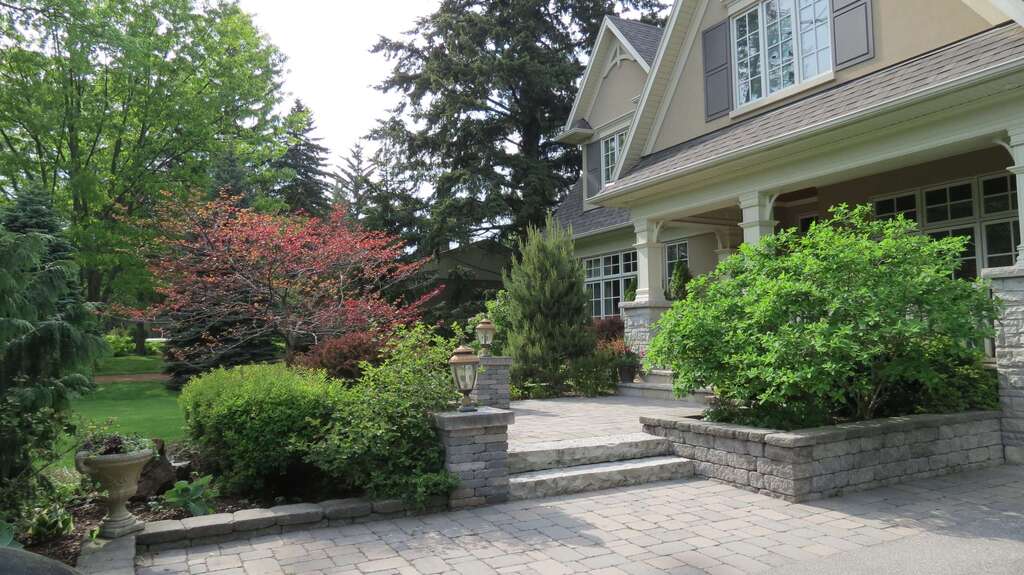Explore this post with:
Choosing between modern and traditional landscape designs can be challenging, as both styles offer unique elements to enhance outdoor space.
Modern design emphasizes clean lines, minimalism, and contemporary materials. Traditional landscaping, on the other hand, focuses on classic beauty, symmetry, and natural elements.
By understanding the key characteristics of each approach, you’ll be better equipped to create a landscape that reflects your personality and meets your aesthetic preferences.
What Is a Modern Landscape Design?
Modern landscape design emphasizes simplicity, clean lines, and a minimalist approach. It often reflects or complements the architecture of your home.
This style bridges the connection between outdoor and indoor spaces by using elements that are not overly ornamental but focus on intentional, understated details.
Incorporating features like an aluminum flagpole can complement either style, adding a sleek, modern touch or serving as a classic focal point.
Key Characteristics of Modern Landscape Design

Modern landscape design is characterized by its emphasis on simplicity, clean lines, and functionality. Here are the key elements that define this style:
1. Unity
Modern landscapes create harmony by ensuring all elements, like plants, hardscaping, and features, work together cohesively. This doesn’t mean everything matches perfectly but rather that there’s a consistent theme in colors, textures, and shapes. It’s like a puzzle where each piece contributes to the overall picture, creating a unified and balanced look.
2. Clean Lines and Geometric Shapes
Modern landscape design focuses on clean, straight lines and geometric shapes such as squares, rectangles, and circles.
Pathways, garden beds, and hardscape elements are often arranged precisely. They give the space a structured and organized feel.
3. Neutral Color Palette
This design style typically uses a muted color palette, including greens, grays, whites, and shades of brown.
The goal is to blend the landscape with the surrounding architecture. This avoids bright or overwhelming colors. Porcelain, stone, or volcanic rock textures are often used to add subtlety and depth.
4. Fewer Plants, Greater Impact
Instead of an abundance of plants, modern landscape design emphasizes fewer species that make a statement. The idea is to create open, uncluttered spaces where each plant serves a purpose, such as providing shade, privacy, or a focal point. Popular choices include succulents, bamboo, and ornamental grasses.
5. Incorporation of Hardscaping
Hardscape elements like large-format pavers, gravel, concrete pathways, and stone walls play a crucial role in modern landscape design. These elements add structure and contrast to the natural components. They enhance the overall aesthetic and creating defined spaces.
6. Technological Integration
Modern landscapes often include technology to enhance functionality, such as outdoor heaters, wired speakers, or phone-controlled lighting systems. These features make the space more comfortable and usable, combining aesthetics with practicality.
What Is a Traditional Landscape Design?
Traditional landscape design emphasizes time-tested elements and classic approaches to create well-defined, beautiful outdoor spaces. It typically features proportional or symmetrical layouts, drawing inspiration from historic gardens like those of classical English, Mediterranean, or French styles. The focus is often on formality, with well-organized plant beds, hedges, and repeated patterns.
Characteristics of Traditional Landscape Design

Here are the key characteristics that define traditional landscape design:
1. Symmetry and Balance
Symmetry is a fundamental aspect of traditional landscape design. This style often incorporates matching plants, pathways, and structures on both sides of a central focal point. It creates a sense of balance and harmony. This structured layout guides the eye and establishes a sense of order. It makes the space feel well-organized and cohesive.
2. Abundant Plantings
Traditional landscapes are known for their lush and abundant greenery. They feature a variety of flowering plants, shrubs, and trees. Also, they have preference for native species that create a full, vibrant look. Using colorful blooms like roses, hydrangeas, and lavender adds charm and visual interest, providing year-round appeal.
3. Curved Pathways and Edges
Unlike modern design, which features straight lines, traditional landscapes often feature gently curved pathways, flower beds, and garden edges.
These winding paths guide visitors through the garden. They create a sense of discovery and inviting exploration. Natural materials like brick, stone, or gravel are typically used, blending seamlessly with the surroundings.
4. Ornamental Details
Ornamental elements are a hallmark of traditional landscape design. This includes decorative garden statues, fountains, birdbaths, and wrought iron benches that add character and a sense of history to the space. These features serve as focal points and enhance the overall aesthetic. They offer an elegant and timeless feel.
5. Natural Color Palette
The color palette in traditional landscapes leans towards softer, natural hues, with shades of green, earthy browns, and subtle pastels.
Seasonal flowers introduce pops of color, but the overall scheme remains harmonious and understated. They complement the garden’s lush greenery and creating a serene environment.
5. Classic Hardscaping
Traditional landscape design often incorporates classic hardscape elements like stone walls, brick walkways, and wooden arbors. These materials add texture and structure to the garden. They enhance its timeless appeal. The hardscape complements the natural beauty of the plants, ensuring the overall design feels cohesive and grounded.
Final Thoughts
When choosing between modern vs. traditional landscape designs, consider how each style aligns with your lifestyle, preferences, and home architecture.
Modern designs offer simplicity, low-maintenance options, and a sleek, minimalist aesthetic. They are ideal for those who value clean lines and functionality.
On the other hand, traditional designs bring classic elegance, symmetry, and the opportunity to create a more intricate, lush garden space.
Don’t be afraid to blend elements from both styles to create a landscape that truly reflects your taste. Start with a clear plan. Always consider the long-term care needs and how the design will evolve with the seasons.
In Case You Missed It!
About the Author: archistyladmin
At Architecturesstyle, we’re passionate about smart design, beautiful spaces, and practical tips that help you bring great architecture into everyday life. Whether it's modern home ideas, iconic buildings, or expert advice, our team brings fresh and useful content to readers who love architecture as much as we do.




